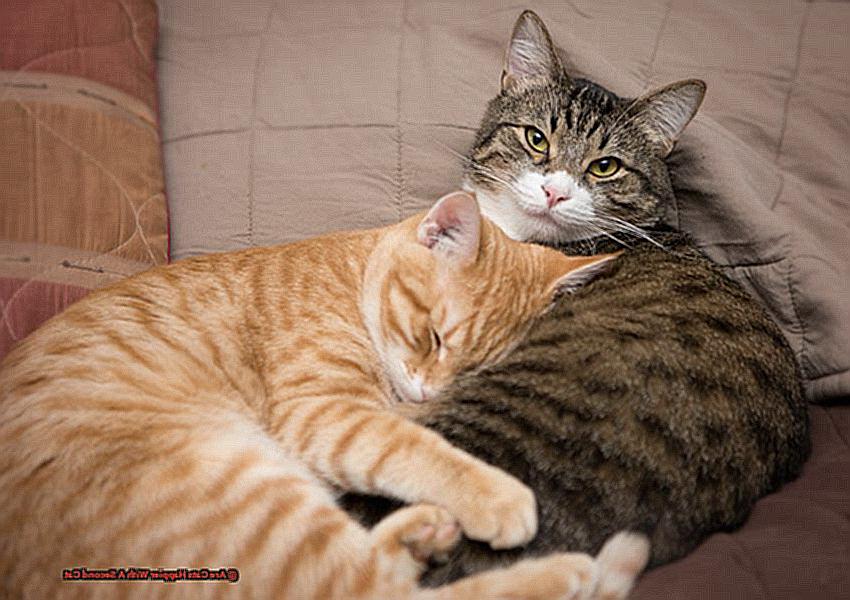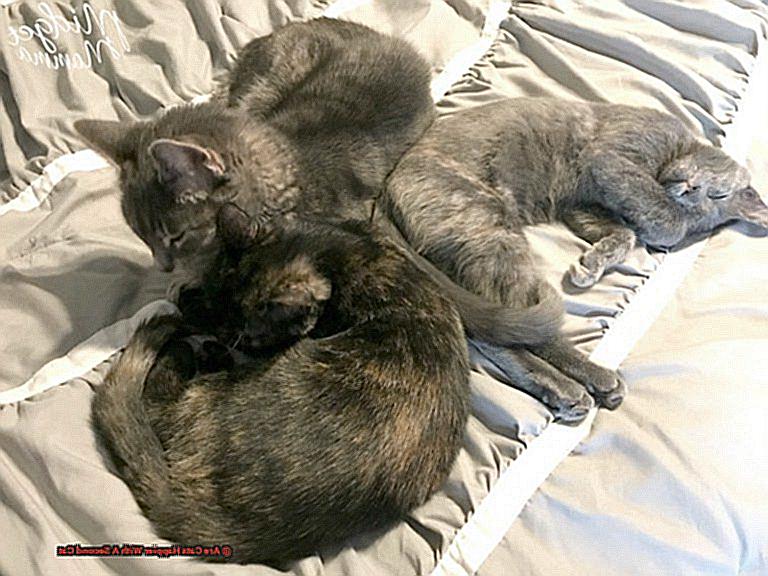Are you a proud cat parent thinking about getting another feline friend?
Or do you already have one furry companion and are curious if they would enjoy having a buddy? The idea of getting a second cat can be both thrilling and nerve-wracking, but have you ever wondered if it could bring more joy to your current kitty’s life?
While there’s no definitive answer, many experts believe that having a companion can enhance your pet’s overall happiness. In this blog post, we’ll delve into the potential benefits of adding another cat to your household and share some tips for successfully introducing them to each other.
So grab a cuppa, snuggle up with your furball, and let’s explore this purrfect topic together.
Are Cats Happier With A Second Cat?
Contents
It’s a common question among cat owners, and the answer is not as straightforward as you may think. While cats are known for their independent nature, they are also social creatures who can form close bonds with other cats. So, let’s dive into the pros and cons of having multiple cats and discover whether your feline companion would benefit from having a furry friend.
The Nature of Cats and Their Potential for Companionship
Cats are solitary animals by nature, but that doesn’t mean they don’t crave companionship. In the wild, cats live in colonies and have a hierarchy within the group. This social structure can also be seen in domestic cats, where they form close relationships with other cats in the household.

However, not all cats are the same. Some cats are more outgoing and social, while others prefer to keep to themselves. It’s essential to consider your cat’s individual personality and preferences when deciding whether to get a second cat.
Introducing A Second Cat: The Pros and Cons
One of the main reasons people consider getting a second cat is to provide companionship for their existing cat. Many cat owners work long hours or have busy schedules, leaving their cats alone for most of the day. Having a second cat can help alleviate loneliness and boredom for both cats.
Additionally, having two cats can provide mental stimulation for both cats as they engage in play and social interactions with each other. This can also result in a decrease in destructive behavior like scratching furniture or excessive meowing.
But there are also potential drawbacks to getting a second cat. Cats are territorial animals and may not easily accept another cat in their space. Proper introduction techniques, such as gradually allowing the cats to get used to each other’s scent and providing separate resources like food bowls and litter boxes, can increase the chances of a successful introduction.
Moreover, not all cats will get along. Some cats may never form a close bond with their feline housemate, and in some cases, may even become aggressive towards each other. It’s crucial to monitor the cats’ interactions and be prepared to separate them if necessary.
The Benefits of Having Multiple Cats
Benefits of Having a Second Cat
While some may hesitate at the idea of having more than one cat, the advantages far outweigh any potential challenges.
Companionship is key when it comes to cats, and having a second cat can provide your existing cat with a constant source of companionship. Cats are social creatures, and they thrive on having feline friends to play, groom, and cuddle with. This can greatly improve their overall happiness and well-being.
But it’s not just about companionship – a second cat also brings endless entertainment for your existing cat. They can engage in feline behavior like chasing each other around the house, playing with toys, and even grooming each other. This not only keeps them mentally stimulated but also provides them with much-needed exercise.
Did you know that cats can also experience stress and anxiety? Just like humans, they can benefit from having a constant source of comfort and security in their companion. A second cat can help reduce their stress levels and provide them with a sense of security, leading to a happier and more relaxed feline.
Boredom is another common issue for cats, especially those who spend a lot of time alone. Having a second cat can alleviate boredom and provide your cats with a playmate to keep them entertained. This can lead to a happier and more fulfilled feline.
Owning multiple cats also means sharing responsibilities such as grooming, playing, and feeding. This can help lighten the load for pet owners and provide a sense of companionship for both cats.
But it’s not just about the benefits for your cats – owning multiple cats can also have health benefits for both humans and cats. Studies have shown that the presence of multiple cats can help reduce stress levels, lower blood pressure, and even boost our immune system.
Introducing a New Cat to Your Household
Adding a new furry friend to the mix can be an exciting and rewarding experience, but it’s important to take the necessary steps for a successful integration.
The first and most crucial step is to consider your current cat’s personality. Is he or she social and friendly with other animals, or more reserved and territorial? This will give you a good idea of how your cat may react to a new feline family member. If you have a cat that is more on the reserved side, it may take some time for them to warm up to the idea of sharing their space with another cat.
Once you have determined that your current cat is open to having a new companion, it’s time to set up a separate room for the new addition. This will give the new cat time to adjust to their surroundings and allow your current cat to become familiar with their scent before meeting face-to-face. It also gives them a safe space to retreat to if needed.
Slowly introducing the two cats through scent is key. This can be done by swapping their bedding or toys, or rubbing a towel on one cat and placing it near the other. By doing this, they will become accustomed to each other’s scent before actually meeting. This will help reduce any initial tension or aggression.
When it comes time for the cats to meet, it’s important to supervise their interactions closely. Keep initial meetings short and gradually increase the amount of time they spend together. It’s normal for there to be some hissing and swatting at first, but as long as there are no signs of aggression, this is a natural part of the process.
It’s also essential to provide both cats with their own resources, such as food bowls and litter boxes. This will help prevent any potential conflicts over sharing resources, which can lead to tension between the cats.
Remember to be patient during this process and don’t rush the cats into spending all their time together. It may take weeks or even months for them to develop a bond, but with proper introductions and supervision, they can learn to coexist peacefully.
If your current cat continues to show signs of aggression towards the new cat, it may be necessary to seek advice from a veterinarian or behaviorist. They can provide helpful tips and strategies to help the cats adjust to each other.
Assessing Your Cat’s Personality
For some of us, that means adding a second cat to the household. But before jumping into the exciting world of multi-cat ownership, it’s important to consider your current cat’s personality. Just like humans, cats have unique personalities that can greatly influence their interactions with other felines. So, how can you determine if your cat is ready for a companion? Let’s break it down.
Observe Their Interactions
The first step in assessing your cat’s personality is to observe their behavior and interactions with you and other animals. Does your cat enjoy being around other cats? Do they seem scared or aggressive when encountering other felines? Are they territorial or do they share toys and space easily? These are all important factors to consider when deciding if your cat is ready for a companion.
Consider Age
Age is another important factor to consider when assessing your cat’s readiness for a new companion. While kittens are typically more adaptable and open to new companions, senior cats may be set in their ways and less likely to welcome a new addition to the household. It’s important to take into account your cat’s age and how it may affect their response to a new cat.
Remember That Every Cat Is Unique
It’s crucial to keep in mind that every cat is unique and may react differently to a new companion. While one cat may thrive in a multi-cat household, another may prefer to be the only pet in the household. It’s important to assess your cat’s individual personality and needs before making a decision about getting a second cat. This will help ensure a successful introduction and a happy home for both cats.
Take It Slow
If you’ve determined that your cat is ready for a companion, it’s crucial to introduce them slowly and carefully. Set up a separate room for the new cat, with their own food, water, litter box, and toys. This will allow each cat to get used to each other’s scent before meeting face-to-face. When you do introduce them, closely supervise their interactions and be prepared to intervene if necessary.
Mental Stimulation and Physical Health for Cats with Companions
Consider adding a second cat to your household. As social animals, cats can greatly benefit from having companionship. Not only does it provide mental stimulation, but it also promotes physical activity and overall happiness.
Research has shown that cats living with companions are less likely to suffer from boredom and depression. This is because they have a playmate to interact with, groom, and engage in hunting-like behaviors together. A study by the University of California, Berkeley even found that having multiple cats can reduce stress levels and improve mental health for both cats.
But it’s not just mental stimulation that multiple cats provide – it also leads to increased physical activity. Cats are natural hunters, and having a companion encourages them to engage in playtime, satisfying their natural instincts and providing much-needed exercise for indoor cats. Additionally, multiple cats in a household tend to engage in social grooming, strengthening their bond and promoting overall well-being.
It’s important to note that introducing a new cat into an established cat’s territory should be done carefully. Gradual introductions, providing separate resources, and monitoring their interactions can help prevent conflicts. But for older or less active cats, having a younger and more playful companion can also encourage them to be more active and promote physical health.
Potential Challenges and How to Address Them
One way to achieve this is by considering adding a new cat to your household. However, like any relationship, introducing a new cat to your home can come with its own set of challenges. To ensure a smooth transition and unlock the full potential of your feline companions, here are some common issues you may face and how to address them.
Territory Disputes:
Cats are known for their territorial nature, and introducing a new cat can disrupt their established sense of territory. This can lead to aggressive behavior, spraying or marking, and even fights. To avoid this, it is essential to introduce the cats gradually. Start by scent swapping – this means swapping items that have each cat’s scent on them, such as bedding or toys. This will help familiarize them with each other’s scents and reduce tension.
Food Competition:
Another common issue when introducing a new cat is food competition. Cats can become very possessive over their food, especially if they were once stray or feral cats. To prevent this, provide separate food bowls for each cat in different areas of the house. This will allow each cat to eat in peace without feeling threatened by the other.
Litter Box Conflicts:
Litter box conflicts can also arise when introducing a new cat. Cats are very particular about where they do their business, so having to share a litter box with another cat can cause stress and lead to litter box aversion. To avoid this, provide multiple litter boxes in different areas of the house and make sure they are kept clean and accessible at all times.
Consistency is Key:
Consistency is crucial when introducing a new cat into your home. This means maintaining their daily routines such as feeding times, playtimes, and bedtime rituals. Consistency helps create a sense of stability and can ease any anxiety or stress the cats may be feeling during this transition.
Seek Professional Help:
In some cases, cats may not get along no matter how gradual the introduction or how many resources are provided. In such situations, seeking advice from a veterinarian or animal behaviorist may be necessary. They can provide guidance and help identify any underlying issues that may be causing conflicts between the cats.
Signs That Your Cats May Not Be Getting Along
Sometimes, this dream can quickly turn into a nightmare when our cats don’t get along. As an expert on cat behavior, I’ve seen firsthand how stressful and concerning it can be when our furry friends show signs of tension towards each other. So, how do you know if there’s trouble brewing between your cats? Here are some signs to watch out for:
- Aggressive Behavior: Cats are known for their independent nature, but they can also be territorial creatures. If you notice your cats hissing, growling, swatting, or even getting into physical fights, it’s a clear sign that there’s tension between them.
- Changes in Eating Habits: Cats are creatures of habit, and any sudden changes in their routine can be a cause for concern. If one of your cats suddenly stops eating or becomes less interested in food, it could be a sign of stress or anxiety due to the presence of a new cat.
- Litter Box Issues: Just like with their food, cats have specific preferences when it comes to using the litter box. If one of your cats starts eliminating outside of the litter box or marking their territory by urinating on furniture or walls, it could be a sign that they are feeling stressed and unhappy with the new addition to the household.
- Avoidance or Fear: Cats also communicate through body language, so it’s essential to pay attention to how they interact with each other. If one cat constantly avoids the other or shows signs of fear such as flattened ears, dilated pupils, or crouching low to the ground, it could indicate that they are not getting along.
- Changes in Demeanor: Our cats may not speak, but they can communicate their feelings through their behavior. If one cat becomes withdrawn, lethargic, or excessively vocal, it could be a sign of stress and unhappiness caused by the new addition to the household.
Conclusion
In conclusion, the decision to bring a second cat into your home should not be taken lightly. While there is no definitive answer on whether cats are happier with a companion, there are numerous potential benefits to having multiple feline friends. From providing companionship and mental stimulation to promoting physical activity and reducing stress, a second cat can greatly enhance your current kitty’s life.
However, it is crucial to consider your cat’s individual personality and preferences before making this decision. Proper introductions and close monitoring of their interactions are vital in ensuring a successful integration into your household. And if challenges do arise, seeking professional help from a veterinarian or behaviorist can offer valuable guidance.
At the end of the day, every cat is unique and may respond differently to having a companion. It is important to assess your cat’s needs and take things slow when introducing them to each other. With patience, understanding, and proper care, you can create a harmonious home where your furry friends can thrive together.






